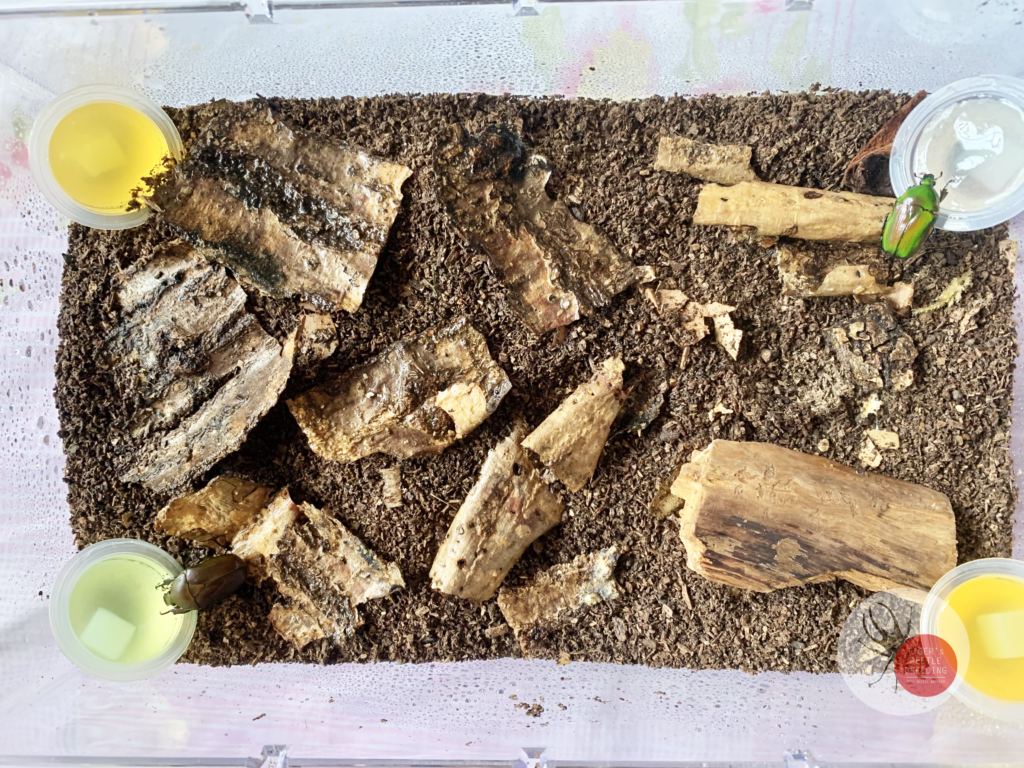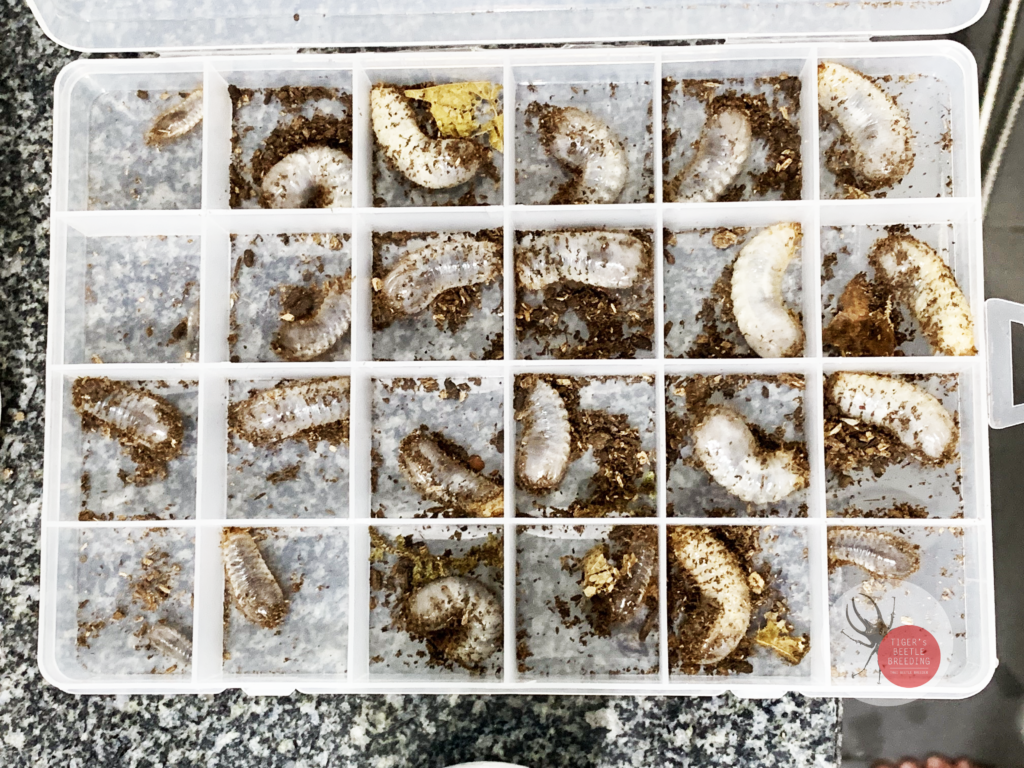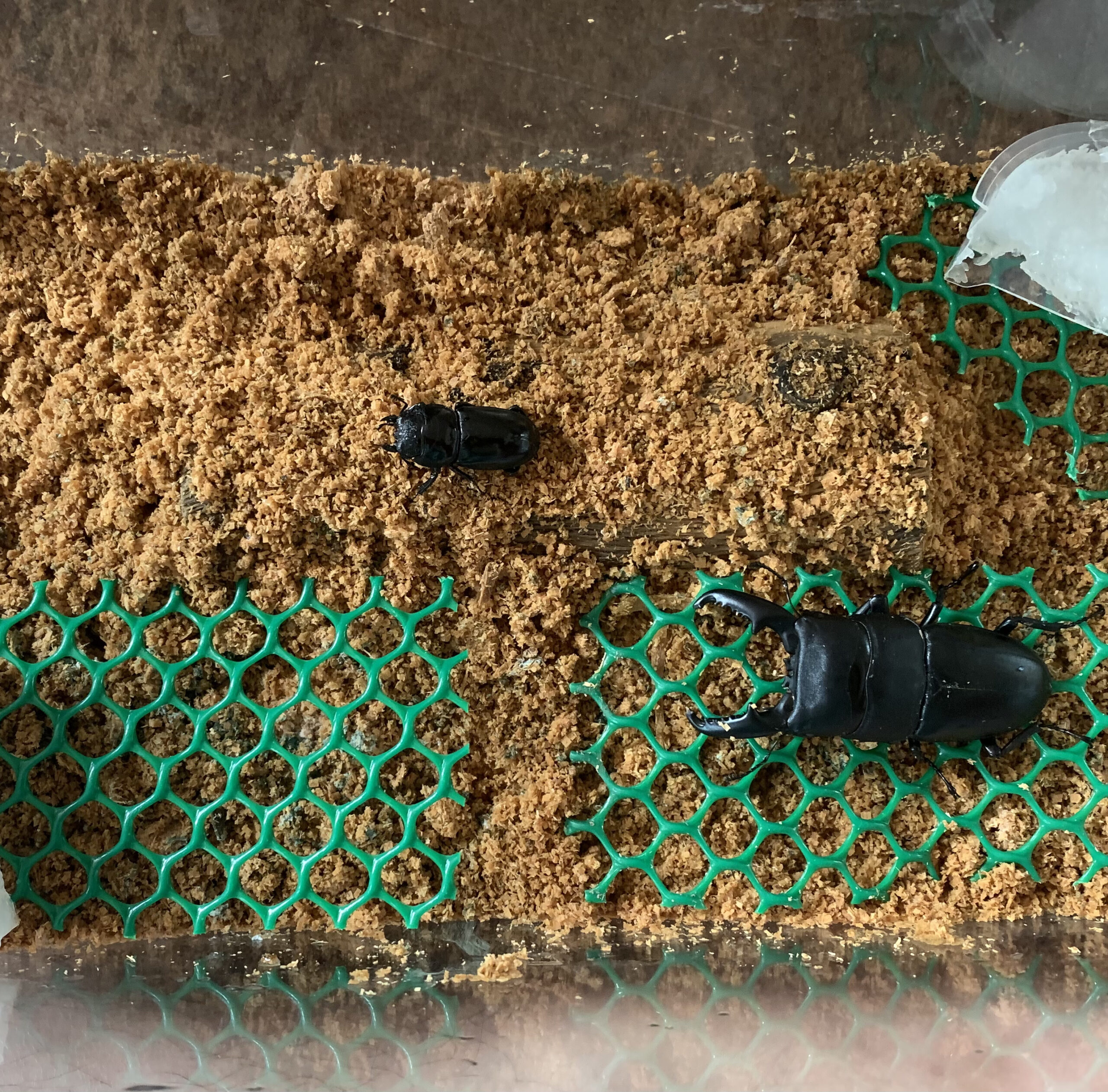Breeding Report of Two Species of Torynorrhina Genus | รายงานการเพาะของด้วงดอกไม้สายพันธุ์โทรีนอรรีทน่า ทั้ง 2 ชนิด
In this breeding report, there are two species of the genus: Torynorrhina which are Torynorrhina flammea and Torynorrhina theimei. Unfortunately, there is some mistake for Torynorrhina theimei, therefore, are not any hatched cocoons. For Torynorrhina flammea, I am able to rear this species from the egg until the adult successfully. Consequently, the most of information and pictures are Torynorrhina flammea.
Torynorrhina sp. is a popular flower beetle from Thailand. They appear during the rainy season from June to August. Their distribution is in Northern Thailand. I got two species of Torynorrhina from Kru Num (Khrū h̄nùm) last year. In my opinion, most breeders quite know Torynorrhina flammea well, and there are a few breeders who succeeded in breeding this species.

ในรายงานการเพาะฉบับนี้ จะกล่าวถึงด้วงดอกไม้ 2 สายพันธุ์ในจำพวกโทรีนอรรีทน่า (Torynorrhina) ได้แก่ ด้วงดอกไม้แฟนซี (Torynorrhina flammea) และ ด้วงดอกไม้สีขี้ม้าปลายขน (Torynorrhina theimei) เป็นเรื่องที่น่าเสียดายของด้วงดอกไม้สีขี้ม้าปลายขน ที่เกิดข้อผิดพลาดบางอย่างในการฟักออกจากกระเปราะดักแด้ จนถึงให้ข้อมูลและรูปโดยส่วนมากมาจากด้วงดอกไม้แฟนซี ซึ่งผู้เขียนสามารถเลี้ยงได้ตั้งแต่ระยะไข่จนถึงระยะเต็มวัยได้สำเร็จ
สายพันธุ์ในจำพวกโทรีนอรรีทน่า เป็นด้วงดอกไม้นิยมจากประเทศไทย พวกมันปรากฎตัวช่วงฤดูฝนในเดือนมิถุนายนถึงสิงหาคม พวกมันกระจ่ายตัวอยู่ในทางตอนเหนือของประเทศไทย ผู้เขียนนั้นได้ด้วงดอกไม้ทั้งสองสายพันธุ์จากครูหนุ่มเมื่อปีที่แล้ว ในความคิดเห็นส่วนตัว ผู้เพาะจำนวนมากรู้จักด้วงดอกไม้แฟนซีเป็นอย่างดร และมีนักเพาะพันธุ์ด้วงจำนวนน้อยที่ประสบความสำเร็จในการเพาะด้วงชนิดนี้

However, I would love to share my report to be the guideline for the people who start to breed such species as Torynorrhina sp. There are a few reports on the internet. I hope that this report will help newbie breeders to know how to breed Torynorrhina sp.
อย่างไรก็ตาม ผมยินดีที่จะแบ่งปัันรายงานฉบับนี้เป็นไกด์ไลร์สำหรับคนที่เริ่มหัดเพาะพันธุ์ด้วงดอกไม้จำพวกจำพวกโทรีนอรรีทน่า ซึ่ง ณ ตอนนี้มีรายงานถึงชนิดนี้น้อยในอินเทอร์เน็ต ผู้เขียนหวังว่ารายงานฉบับนี้จะช่วยเด็กใหม่หัดเพาะให้รู้จักวิธีการเพาะพันธุ์ด้วงดอกไม้จำพวกจำพวกโทรีนอรรีทน่ากันได้
The Method of Breeding | วิธีการเพาะ

The method of breeding is not complicated. They need a specific substrate for laying eggs. And after the eggs hatch, we can put them on the general substrate. A specific substrate that I made consists of cow dung, leaf litter, and flake soil.
Someone might doubt that “Is it important that we have to make a specific substrate?” I had tried various substances for them, but they only laid the eggs on a substance made from cow dung, leaf litter, and flake soil. But I believe that pure flake soil might work as well. So, we have to try many flake soil recipes to find a suitable substance.
For a box, I used a box size of 18 cm. × 29 cm. × 20 cm. the height of the compacted layer is around 5 ~ 7 cm., and the height of the loosed layer is around 3 ~ 5 cm
วิธีการเพาะพันธุ์ไม่ได้ซับซ้อนอย่างที่คิด พวกมันแค่ต้องการรองพื้นที่เฉพาะสำหรับการวางไข่ และหลังจากไข่ฟักเราสามารถใส่พวกมันบนรองพื้นแบบทั่วไป (แมทกว่าง) ได้ วัสดุรองพื้นเฉพาะที่ผู้เขียนทำขึ้นประกอบไปด้วย มูลวัว ใบไม้แห้งบด และแมทกว่าง
บางคนอาจสงสัยว่า “จำเป็นด้วยเหรอที่เราต้องใช้รองพื้นเฉพาะ?” ผู้เขียนได้ลองรองพื้นหลากหลายแบบอยู่นานสำหรับพวกัน แต่พวกมันก็วางไข่เฉพาะตัวรองพื้นที่ทำจากมูลวัวใบไม้แห้งบด และแมทกว่าง ผสมเข้ากัน แต่ผู้เขียนเชื่อว่าแมทกว่างเพียว ๆ อาจใช้งานได้ดีเหมือนกัน ซึ่งเราต้องลองแมทหลาย ๆ สูตรที่เหมาะสมสำหรับพวกมัน
สำหรับขนาดของกล้อง ผู้เขียนใช้กล้องขนาด 18 ซม. × 29 ซม. × 20 ซม. ความสูงของแมทกชั้นอัดแน่นคือประมาณ 5 ~ 7 ซม. และความสูงของชั้นร่วนไม่อัดแน่นคือประมาณ 3 ~ 5 ซม.
Substrate Ingredients | ส่วนผสมของรองพื้นที่ใช้ในการเพาะ
| Ingredients | ส่วนผสม |
| Flake soil: 60% | แมทกว่าง: 60% |
| Leaf litter: 30% | ใบไม้แห้งบด: 30% |
| Cow Dung: 10% | มูลวัว: 10% |
In the table above, I just approximate the ratio of ingredients. You can adjust the ratio depending on their needs (Just try many times to find a suitable one.) For leaf litter, I used dried raintree leaves (Samanea saman). And dung I used fermented cow dung that I bought.
จากตารางด้านบน ผู้เขียนกะอัตราส่วนของส่วนผสมเอา ซึ่งผู้อ่านสามารถปรับอัตราส่วนได้ตามความต้องการของพวกมัน (เพียงแค่ลองหลาย ๆ รอบเพื่อหาอันที่เหมาะสมที่สุด) สำหรับใบไม้ ผู้เขียนได้ใช้ใบก้ามปูแห้ง และมูลวัวหมักที่ซื้อ
How long does it take time from an egg to be an adult? | ใช้เวลานานเท่าไรจากระยะไข่จนถึงเต็มวัย

There is no official research report about the life cycle of Torynorrhina sp. In this session, the information on the life cycle of Torynorrhina sp. (based on Torynorrhina flammea) came from my rough observation.
ในตอนนี้ยังไม่มีงานรายงานวิจัยอย่างเป็นทางการที่ระบุถึงวัฎจักรหรือระยะเวลาตั้งแต่ไข่จนถึงเต็มวัยของด้วงดอกไม้สายพันธุ์โทรีนอรรีทน่าให้เห็นกัน ซึ่งข้อมูลของวัฏจักรของด้วงดอกไม้สายพันธุ์โทรีนอรรีทน่าในส่วนนี้ เกิดจากการสังเกตุอย่างหยาบ ๆ ของผู้เขียนเอง
| Stages | ระยะ |
| Egg : 2 weeks (14 days) | ระยะไข่ : 2 สัปดาห์ (14 วัน) |
| Larva : 7 ~ 9 months | ระยะตัวอ่อน : 7 ~ 9 เดือน |
| Adult : 3 ~ 6 months | ระยะเต็มวัย : 3 ~ 6 เดือน |
Does Torynorrihna sp. use clay to build a cocoon? | ด้วงดอกไม้สายพันธุ์โทรีนอรรีทน่าใช้ดินเหนียวในการทำกระเปราะดักแด้หรือไม่?


In my experiment, I divided the group of rearing larvae into two groups. The first group is rearing in a large box that contains a compacted layer of clay on the bottom of the box, additionally, I put the larvae in a large box together, so I found that they are not cannibalism. The second group is rearing a larva in each small box of 350 ml. with pure flake soil.
As the result, Torynorrihna sp. in two groups are able to build cocoons with pure flake soil or clay. Likewise, some cocoons were built from larval dung too.


ในการทดลอง แบ่งกลุ่มเลี้ยงตัวอ่อนด้วงเป็นสองกลุ่ม กลุ่มแรกถูกเลี้ยงในกล่องใหญ่ที่บรรจุดินเหนียวชั้นอัดแน่นใต้กล่อง นอกจากนี้ผู้เขียนได้ใส่ตัวอ่อนด้วงในกล่องใหญ่รวมกัน ซึ่งผู้เขียนพบว่าพวกมันไม่มีพฤติกรรมกินกันเองแต่อย่างใด ส่วนกลุ่มที่สองถูกเลี้ยงในกล่องเล็ก ๆ ขนาด 350 มิลลิตร ด้วยแมทกว่างเพียว ๆ
ผลปรากฎว่า ด้วงดอกไม้จำพวกโทรีนอรรีทน่าในสองกลุ่มสามารถสร้างกระเปราะดักแด้จากแมทกว่างเพียว ๆ ได้ หรือดินเหนียวก็ได้เช่นกัน ในทำนองเดียวกัน บางกระเปราะก็สร้างจากมูลของตัวอ่อนด้วงดอกไม้เช่นกัน

Mistake During Building The Cocoons | ความผิดพลาดระหว่างสร้างกระเปราะดักแด้
Torynorrihna thiemei is the one that I follow the developement in the larval stage for so long. The larvae of Torynorrhina thiemei are very thin and soft since L1 to L3. After I left the larvae built thier cocoon in a larage box for a month. So, I decided to dismantle the box to find the cocoons. And then I saw the mold in various cocoons. I guessed the species of mold that damaged the cocoons are Fungi beetle killer.
The reason that cocoons get mold might be the old substance that I did not freeze it before using again. Actually, the substance that we reuse, we have to freeze it because the low temperature can kill the disease and mold that damage the larva.
It is a lesson that I realize to mind the mold from substance as much as possible.

ด้วงดอกไม้ขนขี้ม้าเป็นหนึ่งในที่ผมติดตามพัฒนาการในระยะตัวอ่อนมาอย่างยาวนาน ตัวอ่อนของด้วงดอกไม้ขนขี้ม้ามีลักษณะผอมบางมาก ๆ ตั้งแต่ระยะแรกจนถึงระยะที่สาม หลังจากที่ผู้เขียนปล่อยตัวอ่อนสร้างกระเปราะดักแด้ในกล่องใหญ่เป็นระยะเวลาหนึ่งเดือน ผู้เขียนจึงตัดสินใจรื้อกล่องออกมาเพื่อเช็คกระเปราะดักแด้ และผู้เขียนจึงได้พบว่ามีเชื้อราในกระเปราะดักแด้หลายอัน ซึ่งผู้เขียนคาดเดาว่าน่าจะเป็นรากินด้วง
เหตุผลที่กระเปราะดักแด้มีเชื้อราอาจเป็นเพราะรองพื้นเก่าที่ไม่ได้ทำกาแช่แข็งมันก่อนนำมาใช้อีกครั้ง อันที่จริง รองพื้นที่เราต้องการนำกลับมาใช่ใหม่ควรมีการแช่แข็งในอุดมภูมิต่ำจะสามารถฆ่าพวกเชื้อโรคและเชื้อราที่ทำลายตัวอ่อนของด้วง
มันคือบทเรียนที่ทำให้ผู้เขียนตระหนักที่จะระวังเชื้อราจากรองพื้นตราบที่เป็นไปได้



